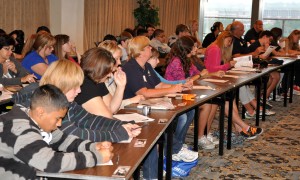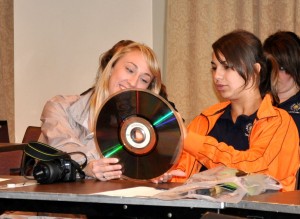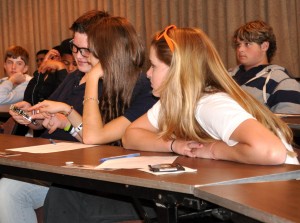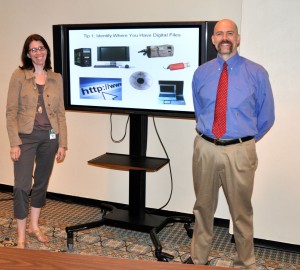It’s many adults’ worst nightmare: how to entertain and (try to) educate thirty 8th graders for an hour? Especially when the subject matter is as potentially complex as how to preserve digital information.
Well, the first thing to do is to try and think like the teenagers who visited the Library on May 13, 2011 from the Imagine Schools South Lake Middle School in Clermont, Fl as part of a class trip to Washington, D.C.
[See a slideshow of images from the event here.]
Lucky for us this wasn’t the first time we’ve engaged with students on the subject of digital culture and its preservation. Back in the summer of 2009 we hosted a visiting group of high schoolers from Arlington, Va., a visit that provided the grist for the “Digital Natives Explore Digital Preservation” video.
The insightful video (seriously, go watch it now) explored teens’ knowledge of digital preservation in general, as well as their ideas of what digital items should be saved, who’s responsible for saving them and what the challenges are in saving them.
Since then, the National Digital Information Infrastructure and Preservation Program at the Library has participated in outreach events at the National Book Festival and has hosted two Personal Archiving Day events at the Library, all of which helped us understand what digital preservation issues were of concern to the general public.
Still, outreach to adults (and near-adults) is a little different than working with 8th graders, so with input provided by Library Educational Resource Specialist Cheryl Lederle-Ensign, we crafted a program that concentrated on a subject near and dear to the students’ hearts: digital photos.
A Pew Internet and American Life Project slide set from June 2010 explodes many of the myths about teen cell phone and social network use, noting that after texting (of course) photo-taking and –sharing is the most popular feature on teens’ cell phones. And kids aren’t alone here: we’ve noted a significant interest in digital photography issues at our other outreach events, so we know this is an area of interest and concern for many.
With that in mind, we tailored our presentation to help the kids understand how to capture, describe and preserve their own digital photos. We started off by querying the South Lake kids on their photo-taking and –saving activities, beginning with the devices they use to take their pictures, then investigating their storage and sharing strategies. Throughout the conversation we shared handy tips they could use at home to help make their pictures last a good, long time.
There was a roughly even split between students who used digital cameras and those who used phones to take their pictures, with one student still using film (!). The split is important, because the primary distribution (and possibly only long-term storage) strategy for many of the phone users was to upload their photos to a social networking site such as Facebook.
We explained some of the issues with using a social network site as a primary storage option (history has shown that those sites don’t stick around forever), and talked about how it’s best to save your photos across a range of devices (thumb drives, CDs, external hard drives, online storage) and geographies (your house in Florida, your friend’s house across town, your grandma’s house in Seattle).
And we were pleasantly surprised by the students’ degree of knowledge on the issues. Most of them recognized that their digital photos were “at-risk” in some way (one had filled her camera by shooting 800 photos in one day and was worried about how to save them when she ran out of space), and many had perfectly reasonable back-up and replication strategies already in place. Our presentation “teased-out” more detail on these strategies, and got both the students and their parental chaperones to think a little harder about saving their photos with something that resembled a long-term strategy.
Through its public outreach NDIIPP is trying to influence behavior on a number of levels, first and foremost by raising awareness of digital preservation issues and spurring people to take personal action to preserve their own materials in the current absence of comprehensive tools to help them do so. After all, the personal photographs of the students at South Lake could become the valuable cultural heritage materials of tomorrow, but only if the students take care of them first.
We’ll talk more about personal archiving tools and strategies in future blog posts, but in the meantime we take our hats off to the students of South Lake and welcome other student groups to come visit us!





No Comments